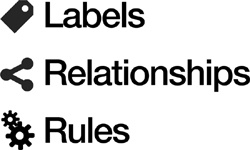Chapter 20. The Materials of Semantic Function
âWhen I use a word,â Humpty Dumpty said in rather a scornful tone, âit means just what I choose it to meanâneither more nor less.â
âThe question is,â said Alice, âwhether you can make words mean so many different things.â
âThe question is,â said Humpty Dumpty, âwhich is to be masterâthatâs all.â
âLEWIS CARROLL, THROUGH THE LOOKING-GLASS
My cow is not pretty, but itâs pretty to me.
âDAVID LYNCH
Elements
TO ADDRESS HOW INFORMATION ARCHITECTURE COMPOSES CONTEXT, we need to look at what materials the practice requires for designing environments. What are the elements that it usesâthe bricks and mortar, studs and joistsâthat create the joinery of coherently nested places?
The material for information architecture is mainly the semantic function of language. Names, categories, links, and conditional actions are not just for organizing objects but for also establishing place and shaping systemic relationships for entire environments. We can distill these elements into three categories (Figure 20-1): Labels, Relationships, and Rules.

Iâve mentioned these in various forms in previous chapters, but bringing them together into a three-part list helps solidify them as a model.
These three items loosely ...
Get Understanding Context now with the O’Reilly learning platform.
O’Reilly members experience books, live events, courses curated by job role, and more from O’Reilly and nearly 200 top publishers.

